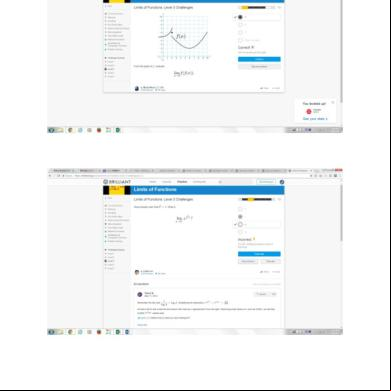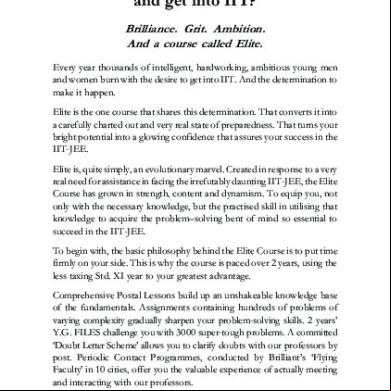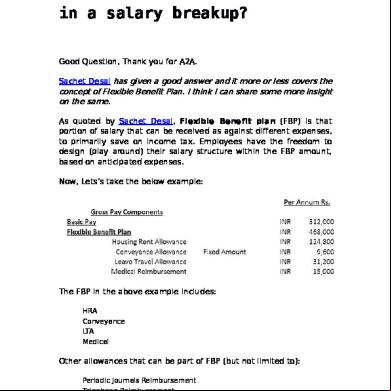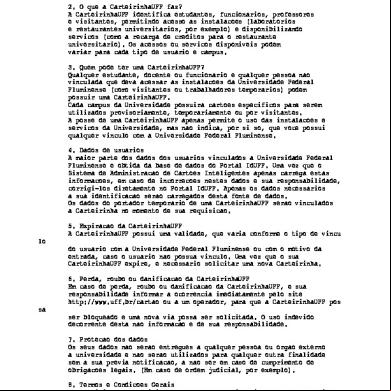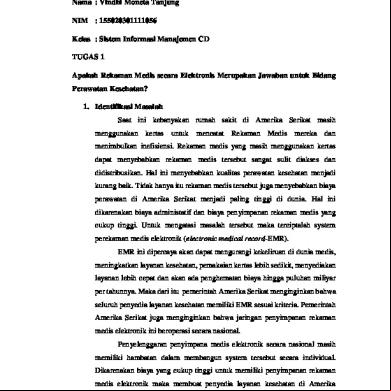Brilliant Org 3n4718
This document was ed by and they confirmed that they have the permission to share it. If you are author or own the copyright of this book, please report to us by using this report form. Report 2z6p3t
Overview 5o1f4z
& View Brilliant Org as PDF for free.
More details 6z3438
- Words: 1,551
- Pages: 7
Use Brilliant to build your problem solving skills in math and science Sign up!
or
Fundamental Theorem of Calculus TAKE QUIZ
In section of the wiki, we will see how the two main branches of calculus( differential and integral) calculus are related to each other. While the two might seem to be unrelated to each other, as one arose from the tangent problem, while the other arose from the area problem, we will see that the fundamental theorem of calculus does indeed create a link between the two.
Contents 1 The first fundamental theorem of calculus 2 Second Fundamental theorem of calculus
The first fundamental theorem of calculus We have learned about indefinite integrals, which was the process of finding the antiderivative of a function. In contrast to the indefinite integral, the result of a definite integral will be a number, instead of a function. The definite integral of a function is the signed area under the graph of the function, and is expressed in the form of: \displaystyle{\int_a^b f(x)dx}.
Now suppose that we formed an area function S(x) in such a way that it is dependent on the function f(x) as: S(x)=\int _{ a }^{ x }{ f(t)dt } Where f is continuous on the interval [a,b]. Know suppose we wanted to find the the rate of change of area with respect to x.
converted by Web2PDFConvert.com
We can see form the figure above that the area of the shaded region is equal to the area from a to x+\Delta x minus the area from a to x. \Delta S=A(x+\Delta x)-A(x) \frac{\Delta S}{\Delta x}=\frac{A(x+\Delta x)-A(x)}{\Delta x} So the rate of change of area becomes: S'(x)=\frac{dS}{dx}=\underset { x\rightarrow 0 }{ lim } \frac { s(x+\Delta x)-s(x) }{ \Delta x} We know that there is an \overline{x} found between x and x+\delta x such that the area of the shaded region is equal to f(\overline{x})\Delta x. S'(x)=\underset { x\rightarrow 0 }{ lim } \frac { S(x+\Delta x)-S(x) }{ \Delta x } =\underset { x\rightarrow 0 }{ lim } \frac { f(\overline { x } )\Delta x }{ \Delta x } \\ \quad \quad \quad \quad \\ \quad \quad \quad \quad \quad \quad \quad \quad \quad \quad \quad \quad \quad \quad =\underset { x\rightarrow 0 }{ lim } f(\overline { x } )\\ \\ \quad \quad \quad \quad \quad \quad \quad \quad \quad \quad \quad \quad \quad \quad \quad =f(x)\\ \\ The last step is true, as \Delta x\rightarrow 0, any thing found between x and x+\Delta x approaches x. So know we are ready to state the first fundamental theorem of calculus. THEOREM
If f is continuous on [a,b] then the function defined by: S(x)=\int _{ a }^{ x }{ f(t)dt } is continuous on [a,b] and differentiable on (a,b) and S'(x)=f(x).
So basically integration is the opposite of differentiation. More clearly the first fundamental theorem of calculus can written in Leibniz notation as: \frac { d }{ dx } \int _{ a }^{ x }{ f(t)dt=f(x) } \\ EXAMPLE
Find the derivative of k(x)=\int _{ 2 }^{ x }{ ({ 4}^{ t }+t)dt } \\ .
The function f is continuous, so from the first fundamental theorem of calculus we have: k'(x)={ 4 }^{ x }+x
converted by Web2PDFConvert.com
EXAMPLE
What is the derivative of h(x)=\int _{ 2 }^{ { x }^{ 2 } }{ \frac { 1 }{ 1+{ t }^{ 2 } } dt } \\ .
We use The first fundamental theorem of calculus in accordance with the chainrule to solve this. Let u=x^{2}, then: \frac { d }{ dx } \int _{ 2 }^{ { x }^{ 2 } }{ \frac { 1 }{ 1+{ t }^{ 2 } } dt= } \frac { d }{ du } \left[ \int _{ 1 }^{ u }{ \frac { 1 }{ 1+{ t }^{ 2 } } } dt \right] \cdot \frac { du }{ dx } \\ \\ \quad \quad \quad \quad \quad \quad \quad \quad \quad \quad \quad \quad =\frac { 1 }{ 1+{ u }^{ 2 } } \cdot 4{ x }^{ 3 }\\ \\ \quad \quad \quad \quad \quad \quad \quad \quad \quad \quad \quad \quad =\frac { 4{ x }^{ 3 } }{ 1+{ x }^{ 4 } } \\
EXAMPLE
Find the derivative of h(x)=\int _{ x }^{ 3x }{ sin\theta d\theta } .
We use the following property of integrals: \int _{ b }^{ a }{ f(x)dx } =\int _{ b }^{ 0 }{ f(x)dx+\int _{ 0 }^{ a }{ f(x)dx } } so h'(x)=\frac { d }{ dx } \int _{ x }^{ 3x }{ sin\theta d\theta } \\ \\ \quad \quad \quad =\frac { d }{ dx } \int _{ x }^{ 0 }{ sin\theta d\theta +\frac { d }{ dx } \int _{ 0 }^{ 3x } { sin\theta d\theta } } \\ \\ \quad \quad \quad =\frac { d }{ dx } -\int _{ 0 }^{ x }{ sin\theta d\theta } +\frac { d }{ dx } \int _{ 0 }^{ 3x }{ sin\theta d\theta } \\ \\ \quad \quad \quad \quad =-sinx+\frac { d }{ du } \int _{ 0 }^{ u }{ sin\theta d\theta } \cdot \frac { du }{ dx } \\ \\ \quad \quad \quad \quad \quad \quad \quad \quad =-sinx+3sin3x
Second Fundamental theorem of calculus
THEOREM
If f is a continuous function on [a,b] then \int _{ a }^{ b }{ f(x)dx=F(b)-F(a) } where F is the anti-derivative of f, that is F'=f.
PROOF
We know form the first fundamental theorem of calculus that if S(x)=\int _{ a }^{ x
converted by Web2PDFConvert.com
}{ f(t)dt } , then S is the anti-derivative of f or S'(x)=f(x). Let F be any other antiderivative of f on the interval [a,b], then we know that F and S differ only by a constant, that is: F(x)=S(x)+c for a<x
This theorem transforms the difficult problem of finding of evaluating definite integrals by calculation limits of sums, into a more easier problem of finding the antiderivative. So for example if asked to compute the integral \int _{ a }^{ b }{ f(x)dx } , we find the antiderivative of f(x) and compute their value at each end-point of the integral, and finally subtract them from each other. EXAMPLE
Evaluate \displaystyle{\int_0^1}x^2dx.
According to the fundamental theorem of calculus, we have \displaystyle{\int_0^1}x^2dx=F(1)-F(0), where F(x) is an antiderivative of x^2. Indefinite integration of x^2 gives \int x^2dx=\frac{1}{3}x^3+C, where C is the constant of integration. Hence we have F(1)-F(0)=\left(\frac{1}{3}\times1^3+C\right)-\left(\frac{1} {3}\times0+C\right)=\frac{1}{3}.\ _\square
Observe that the constant of integration C can be ignored, since it is to be eliminated regardless of its value. EXAMPLE
Find the area under the curve y=x^3+1 from x=-1 to x=1.
Since x^3+1\geq0 over the interval [-1,1], the area under the curve y=x^3+1 from x=-1 to x=1 is equal to \displaystyle{\int_{-1}^1(x^3+1)dx}. Since \frac{1}{4}x^4+x is an antiderivative of x^3+1, the area under the curve is: \begin{align} \int_{-1}^1(x^3+1)dx&=\left[\frac{1}{4}x^4+x\right]_{-1}^1\\ &=\left(\frac{1}{4}\cdot1^4+1\right)-\left(\frac{1}{4}\cdot(-1)^4+(-1)\right)\\ converted by Web2PDFConvert.com
&=\frac{5}{4}-\left(-\frac{3}{4}\right)=2.\ _\square \end{align}
EXAMPLE
Evaluate \displaystyle{\int_{-3}^{2}(2x^2-3x+4)dx.}
Since \displaystyle{\int(2x^2-3x+4)dx=\frac{2}{3}x^3-\frac{3}{2}x^2+4x+C,} We have \begin{align} \displaystyle{\int_{-3}^{2}(2x^2-3x+4)dx}&=\left[\frac{2}{3}x^3\frac{3}{2}x^2+4x\right]_{-3}^{2}\\ &=\left(\frac{2}{3}\cdot2^3-\frac{3} {2}\cdot2^2+4\cdot2\right)-\left(\frac{2}{3}\cdot(-3)^3-\frac{3}{2}\cdot(3)^2+4\cdot(-3)\right)\\ &=\frac{305}{6}.\ _\square \end{align}
EXAMPLE
Evaluate \displaystyle{\int_{4}^{9}\sqrt{x}dx.}
\begin{align} \int_{4}^{9}\sqrt{x}dx&=\int_4^9 x^{\frac{1}{2}}dx\\ &=\left[\frac{2}{3}x^{\frac{3}{2}}\right]_4^9\\ &=\frac{2}{3}\cdot9^{\frac{3}{2}}\frac{2}{3}\cdot4^{\frac{3}{2}}\\ &=\frac{38}{3}.\ _\square \end{align}
EXAMPLE
WHAT IS THE AREA OF THE SHADED FIGURE SHOWN ABOVE? We need to find the area under the curve y=\frac{1}{x} from x=\frac{1}{2} to x=\frac{5}{2}. Since \displaystyle{\int\frac{1}{x}dx=\ln x+C,} the area under the curve is equal to: \begin{align} \int_{\frac{1}{2}}^{\frac{5}{2}}\frac{1}{x}dx&=\left[\ln x\right]_{\frac{1}{2}}^{\frac{5}{2}}\\ &=\ln\frac{5}{2}-\ln\frac{1}{2}\\ &=\ln5.\ _\square \end{align}
converted by Web2PDFConvert.com
EXAMPLE
Evaluate \displaystyle{\int_{-\frac{\pi}{2}}^{\frac{5}{6}\pi}\sin xdx.}
\begin{align} \int_{-\frac{\pi}{2}}^{\frac{5}{6}\pi}\sin xdx&=\left[-\cos x\right]_{\frac{\pi}{2}}^{\frac{5}{6}\pi}\\ &=\frac{\sqrt{3}}{2}.\ _\square \end{align}
EXAMPLE
Find the area under the curve y=2x-x^2 from x=1 to x=2.
Since 2x-x^2\geq0 over the interval [1,2], the area under the curve y=2x-x^2 from x=1 to x=2 is equal to \displaystyle{\int_1^2(2x-x^2)dx}. Since x^2-\frac{1}{3}x^3 is an antiderivative of 2x-x^2, \begin{align} \int_1^2(2x-x^2)dx&=\left[x^2-\frac{1}{3}x^3\right]_1^2\\ &=\left(2^2-\frac{1}{3}\cdot2^3\right)-\left(1^2-\frac{1}{3}\cdot1^3\right)\\ &=\frac{2}{3}.\ _\square \end{align}
Relevant For... Calculus > Properties of Integrals JEE Math (Beta) > Integration
converted by Web2PDFConvert.com
Community Posts
FIND THE INTEGRATION? By Aditya Raj SOLVE THE INTEGRATION IF ANY ONE CAN? Solve this hard Calculus problem.
Log Derivative Integral By Mahindra Jain What is the sum of all the values of x that satisfy ... Solve this hard Calculus problem.
Infinite Integrations?!?! By Sudeep Salgia Let the derivative of F(x) be f(x). Therefore, in general, \int f(x) dx = F(x) + c However, we define a new function \psi that takes a function ... Solve this hard Calculus problem.
A function so cool it wears shades at night ..... By brian charlesworth There exists a unique, positive-valued, non-constant, continuous and differentiable function y = f(x) such that (i) over any specified interval, the area between f(x) and the x-axis is ... Solve this hard Calculus problem.
Load more
Math Algebra Geometry Calculus Combinatorics
Test Prep SAT® Math ACT® Math AP® Calculus AB JEE Math
About Help Privacy Mobile App © Brilliant 2014
SAT® and AP® are ed trademarks of the College Board, which was not involved in the production of, and does not endorse, this product. ACT® is a ed trademark of ACT, Inc.
Practice math and science Follow us!questions on the Brilliant Android app.
converted by Web2PDFConvert.com
or
Fundamental Theorem of Calculus TAKE QUIZ
In section of the wiki, we will see how the two main branches of calculus( differential and integral) calculus are related to each other. While the two might seem to be unrelated to each other, as one arose from the tangent problem, while the other arose from the area problem, we will see that the fundamental theorem of calculus does indeed create a link between the two.
Contents 1 The first fundamental theorem of calculus 2 Second Fundamental theorem of calculus
The first fundamental theorem of calculus We have learned about indefinite integrals, which was the process of finding the antiderivative of a function. In contrast to the indefinite integral, the result of a definite integral will be a number, instead of a function. The definite integral of a function is the signed area under the graph of the function, and is expressed in the form of: \displaystyle{\int_a^b f(x)dx}.
Now suppose that we formed an area function S(x) in such a way that it is dependent on the function f(x) as: S(x)=\int _{ a }^{ x }{ f(t)dt } Where f is continuous on the interval [a,b]. Know suppose we wanted to find the the rate of change of area with respect to x.
converted by Web2PDFConvert.com
We can see form the figure above that the area of the shaded region is equal to the area from a to x+\Delta x minus the area from a to x. \Delta S=A(x+\Delta x)-A(x) \frac{\Delta S}{\Delta x}=\frac{A(x+\Delta x)-A(x)}{\Delta x} So the rate of change of area becomes: S'(x)=\frac{dS}{dx}=\underset { x\rightarrow 0 }{ lim } \frac { s(x+\Delta x)-s(x) }{ \Delta x} We know that there is an \overline{x} found between x and x+\delta x such that the area of the shaded region is equal to f(\overline{x})\Delta x. S'(x)=\underset { x\rightarrow 0 }{ lim } \frac { S(x+\Delta x)-S(x) }{ \Delta x } =\underset { x\rightarrow 0 }{ lim } \frac { f(\overline { x } )\Delta x }{ \Delta x } \\ \quad \quad \quad \quad \\ \quad \quad \quad \quad \quad \quad \quad \quad \quad \quad \quad \quad \quad \quad =\underset { x\rightarrow 0 }{ lim } f(\overline { x } )\\ \\ \quad \quad \quad \quad \quad \quad \quad \quad \quad \quad \quad \quad \quad \quad \quad =f(x)\\ \\ The last step is true, as \Delta x\rightarrow 0, any thing found between x and x+\Delta x approaches x. So know we are ready to state the first fundamental theorem of calculus. THEOREM
If f is continuous on [a,b] then the function defined by: S(x)=\int _{ a }^{ x }{ f(t)dt } is continuous on [a,b] and differentiable on (a,b) and S'(x)=f(x).
So basically integration is the opposite of differentiation. More clearly the first fundamental theorem of calculus can written in Leibniz notation as: \frac { d }{ dx } \int _{ a }^{ x }{ f(t)dt=f(x) } \\ EXAMPLE
Find the derivative of k(x)=\int _{ 2 }^{ x }{ ({ 4}^{ t }+t)dt } \\ .
The function f is continuous, so from the first fundamental theorem of calculus we have: k'(x)={ 4 }^{ x }+x
converted by Web2PDFConvert.com
EXAMPLE
What is the derivative of h(x)=\int _{ 2 }^{ { x }^{ 2 } }{ \frac { 1 }{ 1+{ t }^{ 2 } } dt } \\ .
We use The first fundamental theorem of calculus in accordance with the chainrule to solve this. Let u=x^{2}, then: \frac { d }{ dx } \int _{ 2 }^{ { x }^{ 2 } }{ \frac { 1 }{ 1+{ t }^{ 2 } } dt= } \frac { d }{ du } \left[ \int _{ 1 }^{ u }{ \frac { 1 }{ 1+{ t }^{ 2 } } } dt \right] \cdot \frac { du }{ dx } \\ \\ \quad \quad \quad \quad \quad \quad \quad \quad \quad \quad \quad \quad =\frac { 1 }{ 1+{ u }^{ 2 } } \cdot 4{ x }^{ 3 }\\ \\ \quad \quad \quad \quad \quad \quad \quad \quad \quad \quad \quad \quad =\frac { 4{ x }^{ 3 } }{ 1+{ x }^{ 4 } } \\
EXAMPLE
Find the derivative of h(x)=\int _{ x }^{ 3x }{ sin\theta d\theta } .
We use the following property of integrals: \int _{ b }^{ a }{ f(x)dx } =\int _{ b }^{ 0 }{ f(x)dx+\int _{ 0 }^{ a }{ f(x)dx } } so h'(x)=\frac { d }{ dx } \int _{ x }^{ 3x }{ sin\theta d\theta } \\ \\ \quad \quad \quad =\frac { d }{ dx } \int _{ x }^{ 0 }{ sin\theta d\theta +\frac { d }{ dx } \int _{ 0 }^{ 3x } { sin\theta d\theta } } \\ \\ \quad \quad \quad =\frac { d }{ dx } -\int _{ 0 }^{ x }{ sin\theta d\theta } +\frac { d }{ dx } \int _{ 0 }^{ 3x }{ sin\theta d\theta } \\ \\ \quad \quad \quad \quad =-sinx+\frac { d }{ du } \int _{ 0 }^{ u }{ sin\theta d\theta } \cdot \frac { du }{ dx } \\ \\ \quad \quad \quad \quad \quad \quad \quad \quad =-sinx+3sin3x
Second Fundamental theorem of calculus
THEOREM
If f is a continuous function on [a,b] then \int _{ a }^{ b }{ f(x)dx=F(b)-F(a) } where F is the anti-derivative of f, that is F'=f.
PROOF
We know form the first fundamental theorem of calculus that if S(x)=\int _{ a }^{ x
converted by Web2PDFConvert.com
}{ f(t)dt } , then S is the anti-derivative of f or S'(x)=f(x). Let F be any other antiderivative of f on the interval [a,b], then we know that F and S differ only by a constant, that is: F(x)=S(x)+c for a<x
This theorem transforms the difficult problem of finding of evaluating definite integrals by calculation limits of sums, into a more easier problem of finding the antiderivative. So for example if asked to compute the integral \int _{ a }^{ b }{ f(x)dx } , we find the antiderivative of f(x) and compute their value at each end-point of the integral, and finally subtract them from each other. EXAMPLE
Evaluate \displaystyle{\int_0^1}x^2dx.
According to the fundamental theorem of calculus, we have \displaystyle{\int_0^1}x^2dx=F(1)-F(0), where F(x) is an antiderivative of x^2. Indefinite integration of x^2 gives \int x^2dx=\frac{1}{3}x^3+C, where C is the constant of integration. Hence we have F(1)-F(0)=\left(\frac{1}{3}\times1^3+C\right)-\left(\frac{1} {3}\times0+C\right)=\frac{1}{3}.\ _\square
Observe that the constant of integration C can be ignored, since it is to be eliminated regardless of its value. EXAMPLE
Find the area under the curve y=x^3+1 from x=-1 to x=1.
Since x^3+1\geq0 over the interval [-1,1], the area under the curve y=x^3+1 from x=-1 to x=1 is equal to \displaystyle{\int_{-1}^1(x^3+1)dx}. Since \frac{1}{4}x^4+x is an antiderivative of x^3+1, the area under the curve is: \begin{align} \int_{-1}^1(x^3+1)dx&=\left[\frac{1}{4}x^4+x\right]_{-1}^1\\ &=\left(\frac{1}{4}\cdot1^4+1\right)-\left(\frac{1}{4}\cdot(-1)^4+(-1)\right)\\ converted by Web2PDFConvert.com
&=\frac{5}{4}-\left(-\frac{3}{4}\right)=2.\ _\square \end{align}
EXAMPLE
Evaluate \displaystyle{\int_{-3}^{2}(2x^2-3x+4)dx.}
Since \displaystyle{\int(2x^2-3x+4)dx=\frac{2}{3}x^3-\frac{3}{2}x^2+4x+C,} We have \begin{align} \displaystyle{\int_{-3}^{2}(2x^2-3x+4)dx}&=\left[\frac{2}{3}x^3\frac{3}{2}x^2+4x\right]_{-3}^{2}\\ &=\left(\frac{2}{3}\cdot2^3-\frac{3} {2}\cdot2^2+4\cdot2\right)-\left(\frac{2}{3}\cdot(-3)^3-\frac{3}{2}\cdot(3)^2+4\cdot(-3)\right)\\ &=\frac{305}{6}.\ _\square \end{align}
EXAMPLE
Evaluate \displaystyle{\int_{4}^{9}\sqrt{x}dx.}
\begin{align} \int_{4}^{9}\sqrt{x}dx&=\int_4^9 x^{\frac{1}{2}}dx\\ &=\left[\frac{2}{3}x^{\frac{3}{2}}\right]_4^9\\ &=\frac{2}{3}\cdot9^{\frac{3}{2}}\frac{2}{3}\cdot4^{\frac{3}{2}}\\ &=\frac{38}{3}.\ _\square \end{align}
EXAMPLE
WHAT IS THE AREA OF THE SHADED FIGURE SHOWN ABOVE? We need to find the area under the curve y=\frac{1}{x} from x=\frac{1}{2} to x=\frac{5}{2}. Since \displaystyle{\int\frac{1}{x}dx=\ln x+C,} the area under the curve is equal to: \begin{align} \int_{\frac{1}{2}}^{\frac{5}{2}}\frac{1}{x}dx&=\left[\ln x\right]_{\frac{1}{2}}^{\frac{5}{2}}\\ &=\ln\frac{5}{2}-\ln\frac{1}{2}\\ &=\ln5.\ _\square \end{align}
converted by Web2PDFConvert.com
EXAMPLE
Evaluate \displaystyle{\int_{-\frac{\pi}{2}}^{\frac{5}{6}\pi}\sin xdx.}
\begin{align} \int_{-\frac{\pi}{2}}^{\frac{5}{6}\pi}\sin xdx&=\left[-\cos x\right]_{\frac{\pi}{2}}^{\frac{5}{6}\pi}\\ &=\frac{\sqrt{3}}{2}.\ _\square \end{align}
EXAMPLE
Find the area under the curve y=2x-x^2 from x=1 to x=2.
Since 2x-x^2\geq0 over the interval [1,2], the area under the curve y=2x-x^2 from x=1 to x=2 is equal to \displaystyle{\int_1^2(2x-x^2)dx}. Since x^2-\frac{1}{3}x^3 is an antiderivative of 2x-x^2, \begin{align} \int_1^2(2x-x^2)dx&=\left[x^2-\frac{1}{3}x^3\right]_1^2\\ &=\left(2^2-\frac{1}{3}\cdot2^3\right)-\left(1^2-\frac{1}{3}\cdot1^3\right)\\ &=\frac{2}{3}.\ _\square \end{align}
Relevant For... Calculus > Properties of Integrals JEE Math (Beta) > Integration
converted by Web2PDFConvert.com
Community Posts
FIND THE INTEGRATION? By Aditya Raj SOLVE THE INTEGRATION IF ANY ONE CAN? Solve this hard Calculus problem.
Log Derivative Integral By Mahindra Jain What is the sum of all the values of x that satisfy ... Solve this hard Calculus problem.
Infinite Integrations?!?! By Sudeep Salgia Let the derivative of F(x) be f(x). Therefore, in general, \int f(x) dx = F(x) + c However, we define a new function \psi that takes a function ... Solve this hard Calculus problem.
A function so cool it wears shades at night ..... By brian charlesworth There exists a unique, positive-valued, non-constant, continuous and differentiable function y = f(x) such that (i) over any specified interval, the area between f(x) and the x-axis is ... Solve this hard Calculus problem.
Load more
Math Algebra Geometry Calculus Combinatorics
Test Prep SAT® Math ACT® Math AP® Calculus AB JEE Math
About Help Privacy Mobile App © Brilliant 2014
SAT® and AP® are ed trademarks of the College Board, which was not involved in the production of, and does not endorse, this product. ACT® is a ed trademark of ACT, Inc.
Practice math and science Follow us!questions on the Brilliant Android app.
converted by Web2PDFConvert.com

